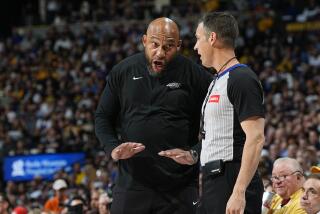What Makes Some Coaches Tick? Itâs Not the Shot Clock
Proponents say itâs about time.
Detractors argue that doesnât make it right.
For the first time, a shot clock is being used statewide in high school boysâ basketball games this season.
The NBA was the first to implement a shot clock in the mid-1950s. A 30-second clock was adopted in 1971 in womenâs college basketball, and high school girlsâ basketball followed suit in 1976. The NCAA approved a 45-second clock in 1985. In 1993, the menâs clock was reduced to 35 seconds.
It took a while for high school boys to catch up.
Last February, the California Interscholastic Federation council passed--by majority vote of the 10 sections--a proposal to use a 35-second shot clock, making California the first state to use a clock in all divisions.
âIt was the right decision,â Trabuco Hills Coach Rainer Wulf said. âThe overriding thing is, every level in the world used a shot clock except high school boys in America. It was like having a different game.â
Based on the first month of the season, many coaches say the shot clock has made little impact.
âThe shot clock has not affected our team one time,â Los Angeles Loyola Coach Alex Acosta said.
Al Bennett, coach at Van Nuys Birmingham, agrees.
âI donât see any difference in the game,â said Bennett, who remains opposed to using a clock.
Bennett, whose team once went to a four-corner stall for seven minutes in a game, said a clock limits strategy.
So did Westchester Coach Ed Azzam, who has one of the strongest and most athletic teams in the state.
âIt takes something away from a team that is at a disadvantage--the use of the clock,â said Azzam, who was against the clockâs implementation. âWeâre really fortunate this year in terms of the talent we have, but when I first started we tried to take a minute or two off the clock each possession just to be in the game.â
Other coaches say the clock actually adds elements of strategy. Wulf, for example, said a press becomes even more effective when coupled with a 35-second time frame.
âEven if your opponent breaks the press, it puts them under a little more pressure to make a decision quickly on offense,â Wulf said. âAnd hopefully for us, that decision turns out to be a bad one for them.â
Area coaches said the clock has had a negligible effect on the game. But not all of them want it to continue past the one-year experiment.
âI still feel I like the game the way it was before,â Century Coach Greg Coombs said. âI havenât seen the game really speed up; but I have seen teams have to shoot wild shots in the last 10 seconds. And itâs everybody, not one team.â
Corona del Mar Coach Paul Orris, who also opposes a shot clock, said using one this season has not changed his mind.
âCall me old-fashioned,â Orris said, âbut having to deal with stalls and those situations made basketball more interesting. Having a clock just to please spectators by having teams running up and down the floor and scoring a lot . . . well, there are other things [about the game] people donât see.
âBut in fact, I would have to say [the clock] is not having a great impact from what we have experienced in our games.â
The shot clock has affected the way some teams play defense. Less-talented teams are using more zones against more athletic opponents. The clock becomes almost like a sixth man on the court.
âOften, the teams that are the most talented are not the most sound fundamentally because they rely on their talent so much,â Fairfax Coach Harvey Kitani said. âThe clock can force them to take a shot they would otherwise pass up while waiting for an opportunity to drive to the basket.â
Dana Hills Coach Mark Thornton said he expected a rise in the use of zone defenses with the shot clock. âIt takes longer to set up a good offense or get off a good shot against a zone. But 35 seconds is enough time,â he said.
Still, many proponents of a high-pressure man-to-man defense have not changed their schemes. Like their colleagues who favor the zone, they see the clock as an ally rather than a nemesis.
âItâs an advantage because we know we have to play tough man-to-man for 35 seconds,â Etiwanda Coach Dave Kleckner said. âIf a team didnât have to shoot, they could wear us down for another 30 seconds or more. It rewards you by saying to the other team, âHey, you guys have to shoot now. You canât wander around passively on the perimeter without doing anything.â â
At Los Angeles High, passivity is not an issue. Nor is the shot clock. John Brooker, the Romansâ coach, said 35 seconds is more than enough time to get an open shot. His players usually shoot not more than 10 seconds after taking possession.
âSome coaches donât like the clock because they like to control things--but itâs the kidsâ game,â said Brooker, whose team scored more than 100 points four times in its first six games. âIf you work them in practice and they know what theyâre doing, theyâll make the right decisions most of the time.â
Lopsided scores, however, are becoming increasingly common because teams are unable to slow the pace. In the past, a team winning or losing in a rout could hold the ball as seconds ticked off the clock. Now, the team has to shoot.
Palmdale Coach Garry Phelps used that fact to his advantage earlier this season against Granada Hills. Palmdale trailed by three points with about two minutes left in overtime when Phelps realized his team would have plenty of chances to catch up.
âI thought, well at least we donât have to go out and foul somebody, because we had the shot clock,â he said.
Palmdale got the ball back several times and outscored Granada Hills, 13-4, in the final minutes and won, 93-87.
Phelps, who considers himself a conservative coach, doesnât count himself among advocates of the clock. Like so many coaches, though, he has learned to go with the flow.
âIâll probably get used to it,â he said, âjust like I got used to the three-pointer.â
*
Times staff writer Mike Terry contributed to this story.
More to Read
Sign up for Essential California
The most important California stories and recommendations in your inbox every morning.
You may occasionally receive promotional content from the Los Angeles Times.











